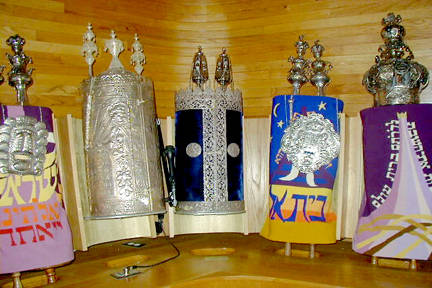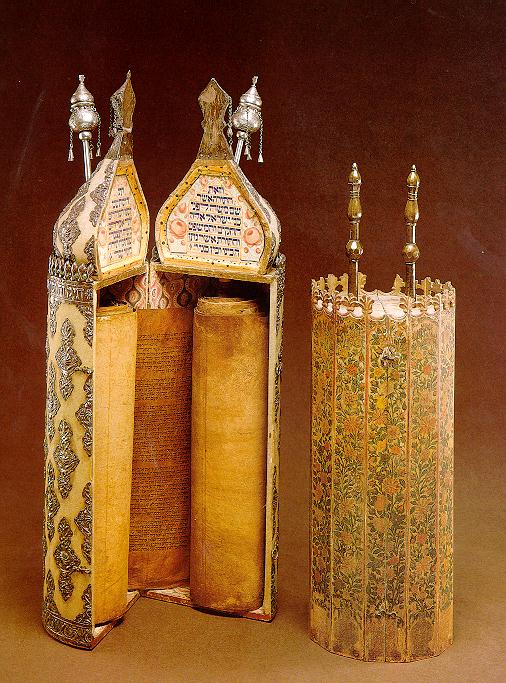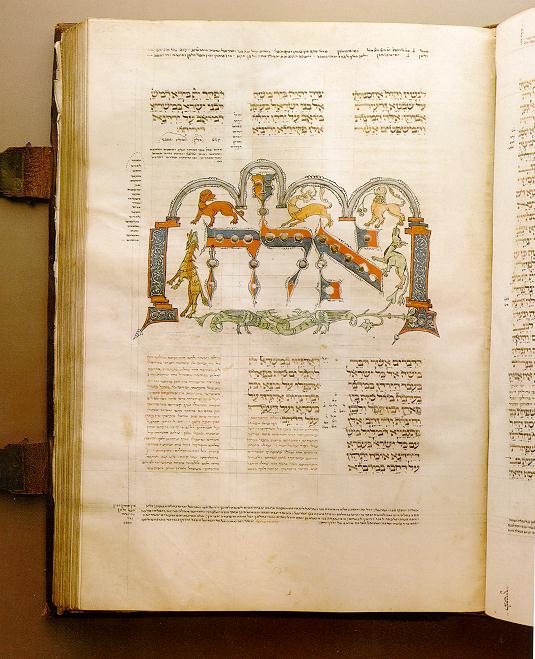|
|
|
 |
Torah Scrolls |  |
|
Facts about Torah Scrolls |
||
| The Torah
Close-up of the ark The Torah Shebiktav has three parts: Torah: This is the part that was given directly to Moshe Rabbeinu (Moses our Teacher) at Mount Sinai. It is made up of five books. Each book is called a Chumash. Bereishit (Genesis) Shemot (Exodus) Vayikra (Leviticus) Bamidbar (Numbers) Devarim (Deuteronomy) Neviim (Prophets): Prophets are great and saintly people who communicate with G-d. These books are recordings of some of what G-d said to His prophets. Yehoshua (Joshua) Shoftim (Judges) Shmuel (Samuel) - two books Melachim (Kings) - two books Yirmiyahu (Jeremiah) Yechezkel (Ezekiel) Yeshayahu (Isaiah) The following twelve are combined in one book called Trey Asar (The Twelve): Hoshaia (Hosea) Yoel (Joel) Amos Ovadiah (Obadiah) Yonah (Jonah) Michah (Micah) Nachum (Nahum) Chabakkuk (Habakkuk) Tzefaniah (Zephaniah) Chaggai (Haggai) Zechariah (Zachariah) Malachi Ketuvim (Writings): These books were written by prophets with G-d's guidance but are not direct prophecies. Tehillim (Psalms) Mishlei (Proverbs) Iyov (Job) The following five books are called Megillot: Shir HaShirim (Song of Songs) Ruth Eichah (Lamentations) Kohelet (Eclesiastes) Esther Daniel Ezra & Nechemiah Divrei HaYamim (Chronicles) two books All together there are 24 books, five in the Torah, eight in the Neviim, and eleven in the Ketuvim. These three sections (Torah, Neviim, and Ketuvim) are frequently referred to by the acronym TaNaKh (or Tanach). Many things are not explained in the Torah Shebiktav. G-d gave the explanations to Moshe Rabbeinu on Mount Sinai together with the Written Torah. These explanations are called the Torah Shebeal Peh, the Oral Torah, because they were meant to be passed from teacher to student. In the years after the destruction of the second Beit HaMikdash (Holy Temple) there was a danger that the Torah Shebeal Peh would be forgotten. Therefore, our Sages, led by Rabbi Yehudah HaNasi (The Prince), assembled a basic outline of the Torah Shebeal Peh into a series of books called the Mishna. The Mishna was completed in the year 188 CE. The Mishna was intended to serve as a memory aid so that it would be easier for students to remember the Torah Shebeal Peh. The Mishna was primarily an outline and did not include the in-depth analysis and explanation behind the laws. These explanations are called Gemara. About three hundred years after the completion of the Mishna there was a risk that the Gemara would be forgotten. Once again, our sages, now led by Rav Ashi and Ravina, compiled the Gemara into a written work as a commentary on the Mishna. This completed work is called the Talmud. The Talmud is therefore the complete collection of the Mishna and the Gemara. The Talmud is made up of six sections. Each section is called a Seder (Order) and contains several books called Masechtos (Tracts). The six Sedarim (Orders) are: Zeraim (Seeds), this section deals with the laws of agriculture. It also deals with the laws of prayer and blessings. It contains 11 Masechtos. Moed (Season), this section deals with the laws of Shabbat and Yom Tov (holidays). It contains 12 Masechtos. Nashim (Women), this section deals with the laws of marriage and divorce. It contains 7 Masechtos. Nezikin (Damages), this section deals with civil law, such as laws about damages and theft. It also deals with ethics. It contains 10 Masechtos. Kedoshim (Holy Things), this section deals with sacrifices. It contains 11 Masechtos. Taharat (Purities), this section deals with laws of ritual purity. It contains 12 Masechtos. |
||
 The Torah Scrolls The Torah has two sections, the Torah Shebiktav (the Written Torah) and the Torah Shebeal Peh (the Oral Torah). |
||
| A closer look at the Torah Scrolls
The word torah means "a teaching". The Torah is G-d's teaching to the Jewish people. In the Torah G-d tells us how to live. The Torah is also called "Torat Chaim", the guide to life. The Torah has many mitzvot (commandments) in it. They are G-d's instructions to us. The Torah also contains stories. These stories are true and teach us about our history and our relationship with G-d. A closer look at what thes scrolls look like. These scrolls maybe as long as 25 metres.They are read right to the left of the page. |
||
 Yemenite and Iranian Torah Scrolls, 19th-20th |
||
| A Bound Torah Not all Torahs are found in the form of scrolls. Some can be found in a form of a usual book as this image illustrates. The book will still be written in Hebrew and is aslo read from right to left. | ||
 Hebrew Illuminated Pentateuch: Deuteronomy I. |
||